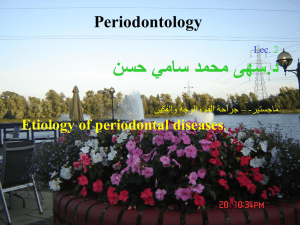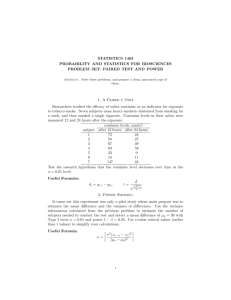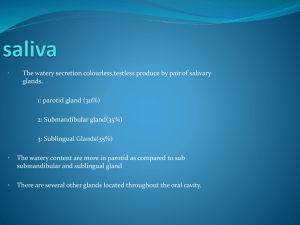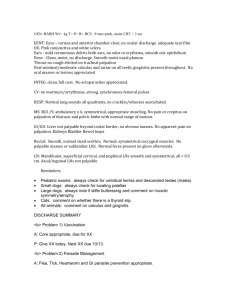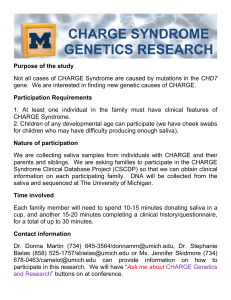Global Journal of Medical research: Diseases
advertisement
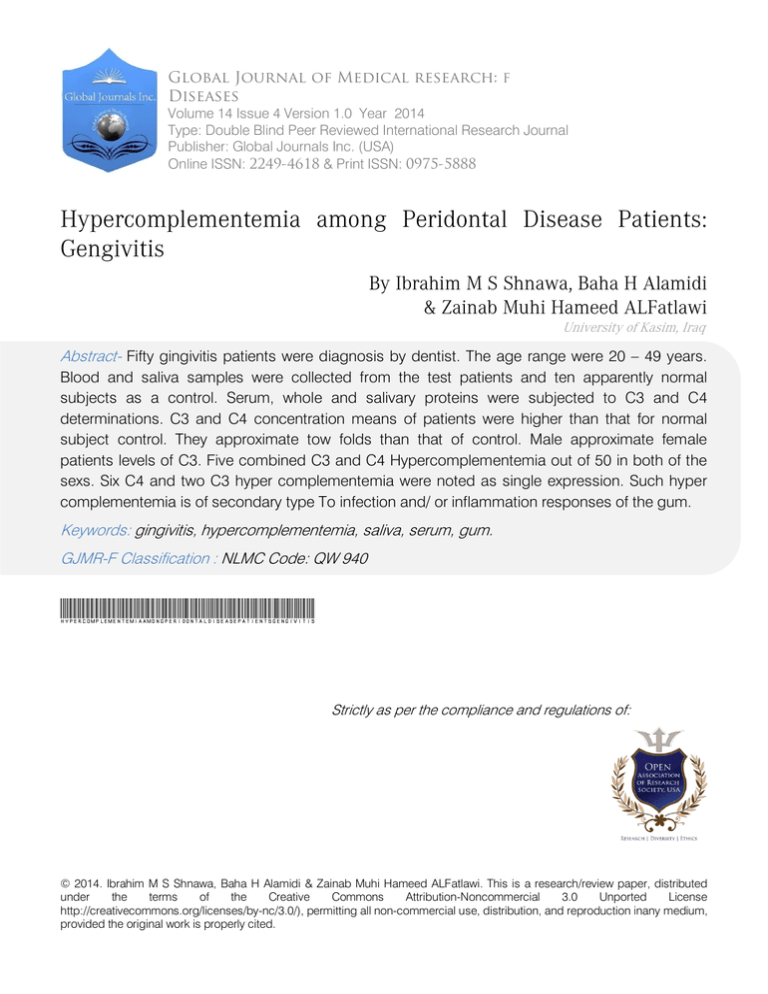
Global Journal of Medical research: F Diseases Volume 14 Issue 4 Version 1.0 Year 2014 Type: Double Blind Peer Reviewed International Research Journal Publisher: Global Journals Inc. (USA) Online ISSN: 2249-4618 & Print ISSN: 0975-5888 Hypercomplementemia among Peridontal Disease Patients: Gengivitis By Ibrahim M S Shnawa, Baha H Alamidi & Zainab Muhi Hameed ALFatlawi University of Kasim, Iraq Abstract- Fifty gingivitis patients were diagnosis by dentist. The age range were 20 – 49 years. Blood and saliva samples were collected from the test patients and ten apparently normal subjects as a control. Serum, whole and salivary proteins were subjected to C3 and C4 determinations. C3 and C4 concentration means of patients were higher than that for normal subject control. They approximate tow folds than that of control. Male approximate female patients levels of C3. Five combined C3 and C4 Hypercomplementemia out of 50 in both of the sexs. Six C4 and two C3 hyper complementemia were noted as single expression. Such hyper complementemia is of secondary type To infection and/ or inflammation responses of the gum. Keywords: gingivitis, hypercomplementemia, saliva, serum, gum. GJMR-F Classification : NLMC Code: QW 940 HypercomplementemiaamongPeridontalDiseasePatientsGengivitis Strictly as per the compliance and regulations of: © 2014. Ibrahim M S Shnawa, Baha H Alamidi & Zainab Muhi Hameed ALFatlawi. This is a research/review paper, distributed under the terms of the Creative Commons Attribution-Noncommercial 3.0 Unported License http://creativecommons.org/licenses/by-nc/3.0/), permitting all non-commercial use, distribution, and reproduction inany medium, provided the original work is properly cited. Hypercomplementemia among Peridontal Disease Patients:Gengivitis Ibrahim M S Shnawa α, Baha H Alamidi σ & Zainab Muhi Hameed ALFatlawi ρ Keywords: gingivitis, hypercomplementemia, saliva, serum, gum. I. C Introduction omplement system serves both of natural and adaptive immune responses, since properdin pathway serves in natural and classical pathway is operable in adaptive responses (1,2,3). The actual levels of complement components are different in different health state of vertebrate including man (4). From the diagnostic point of view there are three complement component concentration levels. The normocomplementemia, hypo and hyper complementemia ( 5,6 ) which corresponds to health, difficient and excess of complement concentration levels respectively. Among the Disease conditions that are associated with hyper complementemia is in infectious disease (7,8 ). The aim of the present work was to determine complement C3, C4 levels in both serum and saliva of the gingivitis patients. II. Material And Methods a) Patients (9) and controls Fifty gingivitis patient from both males and females were clinical diagnosed by the specialized dentists (9) Ten apparently normal mouth hygeine subjects were elected as control . Year From both gingivitis patients and controls saliva were collected as recommended by salimeteres (10). Salivary protein was separated using 6% .polyethylene glycol 6000 as protein precipitant (11) 2014 c) Sliva and Salivary Proteins d) Single Radial Immunodiffusion Partigen diffusion plates containing anti C3 and anti C4 ready made, were used for determination of C3 15 and C4 both is in sera and saliva and salivary proteins (12) e) Biometery Mean, median, range as well a, standard errors were calculate as Steel et al (13) III. Results a) Serum and Salivary C3 The C3 concentration means for gingivitis patients were higher than that of controls. Male and female patients were showing an approximate concentration mean levels. There were individual and age group wise variations noted among the gengivitis patients C3 concentration means Figure-1. There was one peak graph, such graph can be useful as a probe for human herd immunity among gingivitis patients. In comparison saliva, salivary proteins were negative for C3 of the patients and controls. Table 2,5 figure 1. b) C4 serum and salivary concentrations The C4 concentration means for patients and controls were determined. They higher in patients them in controls. Though saliva and salivary proteins were negative for presence of C4. Table 3 ,6,figure 2. c) C3 and c4 serum hypercomplementemia There were two male And there female gingivitis patients will combinedC3, C4 hyper complementemia. Two female patients with C3 hypercomplementemis and six C4 Hpercomplementemia in single expression from both sex Table 4. b) Blood sampling Blood samples without anti-coagulants in a rate of 5ml in plane tubes were collected from both of patients and controls (10) Author α: College of Biotechnology, University of Kasim, Kasim, Babylon/Iraq. Author σ ρ: College of Dentistry, University of Babylon/Babylon/Iraq. e-mail: ishnawa@yahoo.com © 2014 Global Journals Inc. (US) Global Journal of Medical Research ( FD ) Volume XIV Issue III Version I Abstract- Fifty gingivitis patients were diagnosis by dentist. The age range were 20 – 49 years. Blood and saliva samples were collected from the test patients and ten apparently normal subjects as a control. Serum, whole and salivary proteins were subjected to C3 and C4 determinations. C3 and C4 concentration means of patients were higher than that for normal subject control. They approximate tow folds than that of control. Male approximate female patients levels of C3. Five combined C3 and C4 Hypercomplementemia out of 50 in both of the sexs. Six C4 and two C3 hyper complementemia were noted as single expression. Such hyper complementemia is of secondary type to infection and/ or inflammation responses of the gum. Hypercomplementemia among Peridontal Disease Patients:Gengivitis Table 1 : The study Gingivitis Patients ـــــــــــــــــــــــــــــــــــــــــــــــــــــــــــــــ NO Gender ـــــــــــــــــــــــــــــــــــــــــــــــــــــــــــــــ 24 26 Male Female 50 ------------------------------------------------------------------------------------------------- Total Table 2 : Age group distribution of the gingivitis patients numbers Age group ---------------------------------------------------20 – 24 07 2014 25 – 29 07 30 - 34 14 35 – 39 11 40 - 44 10 45 – 49 01 ــــــــــــــــــــــــــــــــــــــــــــــــــــــــــــــــــــــــــــــــــــــــــــــــــــــــــــــــــــــــــــــــــــــــــــــــ Total 50 Year _________________________ ____________________________ 16 Table 3 : The c3 concentration means in gingivitis patient stern 163 . 391 Male 168 . 111 female 165.7 Total 27.36369 20.814421 4.97322 4.08204 SD : Male Female SE : Male Female 0.76697 t test ; P 0.026397 )(r 106.06 Controls : Male Female 98.5 Total 90.95 Global Journal of Medical Research ( F ) Volume XIV Issue III Version I ) Mean c3 (Mg/dl Gander Table 4 : The C4 concentration means in the gingivitis patient ـــــــــــــــــــــــــــــــــــــــــــــــــــــــــــــــ ـــــــــــــــــــــــــــــــــــــــــــــــــــــــــــــــ Gender c4 concentration means Mg/dl. ـــــــــــــــــــــــــــــــــــــــــــــــــــــــــــــــ ـــــــــــــــــــــــــــــــــــــــــــــــــــــــــــــــ 47 . 316 Male Female 47 . 143 ـــــــــــــــــــــــــــــــــــــــــــــــــــــــــــــــــــــــــــــــــــــــــــــــــــــــــــــــــــــــــــــــــــــــــــــــــ Total 47 . 249 SD:Male 3.18574 Female 3.1685 SE: Male 0.65029 Female 0.6337 t- test,P 0.98997 )(r - 0.159734 ـــــــــــــــــــــــــــــــــــــــــــــــــــــــــــــــــــــــــــــــــــــــــــــــــــــــــــــــــــــــــــــــــــــــــــــــ Controls :Male 31.08 Female 33.2 Total 32.111 ـــــــــــــــــــــــــــــــــــــــــــــــــــــــــــــــ ـــــــــــــــــــــــــــــــــــــــــــــــــــــــــــــــ )© 2014 Global Journals Inc. (US Hypercomplementemia among Peridontal Disease Patients:Gengivitis Table 5 : Hypercompelmentemia c3 , c4 among Gingivitis Patient ـــــــــــــــــــــــــــــــــــــــــــــــــــــــــــــــ ـــــــــــــــــــــــــــــــــــــــــــــــــــــــــــــــ 𝐶𝐶4 𝑀𝑀𝑀𝑀𝑀𝑀𝑀𝑀𝑀𝑀 𝑐𝑐𝑐𝑐𝑐𝑐 𝑐𝑐𝑐𝑐𝑐𝑐𝑐𝑐 . 50.3 51.8 50.3 50.3 53.4 2014 50.4 50.3 50.3 50.3 51.8 50.3 ------- sex 𝐶𝐶3 Age Year ــــــــــــــــــــــــــــــــــــــــــــــــــــــــــــــــــــــــــــــــــــــــــــــــــــــــــــــــــــــــــــــــــــــــــــــ 36 F 197.4 Combined 42 M 197.4 27 M 197.4 27 F 192.4 27 F 205.5 ـــــــــــــــــــــــــــــــــــــــــــــــــــــــــــــــــــــــــــــــــــــــــــــــــــــــــــــــــــــــــــــــــــــــــــــ Single 23 M --32 M --37 F --29 M --43 M --38 M --36 F 187.4 35 F 192.4 ـــــــــــــــــــــــــــــــــــــــــــــــــــــــــــــــ ـــــــــــــــــــــــــــــــــــــــــــــــــــــــــــــــ 17 Global Journal of Medical Research ( FD ) Volume XIV Issue III Version I 250 200 150 100 1Series 50 0 30 20 10 20 10 )(A Male 0 250 200 150 100 1Series 50 0 30 )© 2014 Global Journals Inc. (US 0 )(B Female Hypercomplementemia among Peridontal Disease Patients:Gengivitis 250 200 1Series 2Series 150 100 50 Year 2014 0 (C) Male & Female 1 3 5 7 9 11 13 15 17 19 21 23 25 Figure 1 : The distribution of C3 among male(A),female(B) and total(C) the x axis is number of patients,the y axis is the concentration Global Journal of Medical Research ( F ) Volume XIV Issue III Version I 18 60 40 1Series 20 0 (A) Male 0 10 20 30 0 10 20 30 60 50 40 30 20 10 0 1Series (B) Female 120 100 80 2Series 60 1Series 40 20 0 (C) Male & Female 1 3 5 7 9 11 13 15 17 19 21 23 25 Figure 2 : The C4 complement distribution among male(A),female(B)and total(C).The x axis is the concentration and the y axis is the number of patients © 2014 Global Journals Inc. (US) Hypercomplementemia among Peridontal Disease Patients:Gengivitis References Références Referencias 1. Whahley K. 1986 Methods In Complement For clinical immunologists. Churching – living stone, U. K. 2. Cruze J.M. and Lewis Gr. 1993 Complement Today Kregr, Orew York. 3. Paul W. 2003. Fundamental Immunology. 4. Ahmed, A.ER. And peter J.B. 1995. Clinical Utility of complement assessment Mini review. Clin. Diag. lab. Immumol 2(5): 509 – 517. 5. Veetil, Bharath, Osloorn, Thomas Mayer and Dean 2011. Extreme hyper complementemia in a setting of mixed cryoglobulinemia, Clin. Rheumatol. 30 (3); 2014 The C3 and C4 concentration means were determined Tables 1-4, Figure l. Patients were showing higher C3, C4 concentration mean than controls. Male and enhance female were with comparable concentration means. Saliva and salivary proteins were negative for both c3 and c4 .c3 concentration means can be of use as a probe for gingivitis human herd immunity The antigens of the dental microbial pathogen on chronic low grade state facing the stomial mucosal immune compartment may leads to stimulation of c3,c4 in serum concentration reaching the limits of secondary hyper- compelementimeia (14,15) . Thus, it may cause the formation of immune complex formation and deposition in the soft gum and periodontal tissues leading to nalifying c3 , c4 in concentration in saliva (16) this nullification may influence the initiation of the activation of classical complement pathway, since c3 and c4 inter played a crucial role in such activation process (17,18,19,20 ) Due to tissue micro-environmental signals the c3 and c4 synthesizing and secreting cells will either enhanced to produce or down regulated to inhibit the catabolic and to anabolic synthesis pathways for both c3 and c4 to meals the tissue immune physiological need for complement proteins (18) Thus, on conclusion one may sum up the findings as 1. C3, c4 concentration means are elevated in gingivitis patients in the systemic but not in mucosal compartment. 2. Single c3, single c4 and c3 – c4 combined hype ramp lenentcmi were reported in gingivitis patients. 3. Serum c3, c4 concentration means were of comparable levels in both of male and female patients. 4. C3 levels among gingivitis patients may be of use as a probe for gingivitis human herd immunity. 8. Haffajee A.D. Socransky SS 1994. Microbial etiology agents of distructive periodontal diseases Peridontol 5;78 – 111. 9. Singh B .and Singh R. 2013. Gingivitis A silent disease J. Dent. Med. Sci. (IOSR _ JDMS ) 6(5) ; 30–33. 10. Salimeterics 2013. Saliva collation and Handling 3rded. Saliva B co. A Salimeteries L L Co. 11. Shawna I M S. and AL Sadi MAK 2001. Mucosal immune globulin, Separation, partial characterization and Utility as infection probe Iraq. J. Microbial 13 (3): 12. Stevens D. C .2010 .Clinical Immunology and Serology. A Laboratory Perspective 3rd. ed, Davis Co. USA. 13. Steel R .G.D, T Orrick J. H. and Dickey D. A. Principles and Procedures for Statistics. A 19 Biometeric Approach 3rded. McGraw-Hill INC New york. 14. Marcheskey AM and Wick M.R. 2014. Pathology of mediastinum. Cambridge University Press. 15. Boacklc R.J. 1991. Interaction of salivary secretion with human complement system. A Model for the study of host defense system on inflamed surfaces Crit. Per. Oral. Boil. Med 2(2): 355–367. 16. Thomas S.G., Boacklc R.J., Long, K., Lass J. and Med of M. E. 1990. Identification and isolation of two forms of decayacclyeration factors D A F. from Parotic saliva FASES J .4:2852. 17. Haffajee AD, Socransky SS 1994. Microbial aetiologic agents of distructive periodontal disease Peridontol. 5:78 – 11. 18. Palyfair J .HL . And chain B .M. 2001. Immunology At a Glance 7thed. Black well Scientific, Tahran 16– 10. 19. Walsh L.J. Clinical Aspects of Salivary biology for Dental clinician. 20. Aurer A,Srdjak T, Palancak D, Starlijenio-Rukavina A and Aurer-Kozelj J Proinflammatory factors in saliva as a possible marker for periodontal disease, Coll. Anthropol. 29(2):435-439. Year Discussion Global Journal of Medical Research ( FD ) Volume XIV Issue III Version I IV. 415. 6. Marchesky A. M and Wick, MR. 2014. Pathology of mediastinum. Cambridge University Press 7. Samakanayake L .P. and Jones B. M. 2002 Essentials of Dental Microbiology Churchill living stone, London. © 2014 Global Journals Inc. (US)
